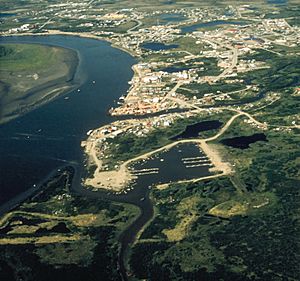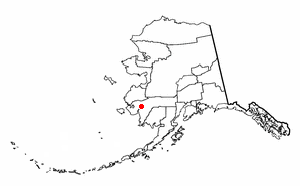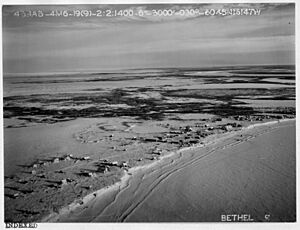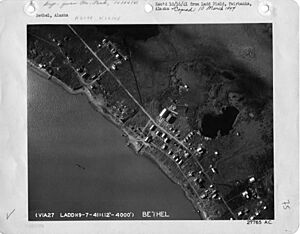Bethel, Alaska facts for kids
Quick facts for kids
Bethel, Alaska
Mamterilleq
Orutsaraq
|
|
|---|---|

Aerial view of Bethel on the Kuskokwim River
|
|

Location of Bethel within the state of Alaska
|
|
| Country | United States |
| State | Alaska |
| Borough | Unorganized |
| Census Area | Bethel |
| ANCSA regional corporation | Calista |
| Incorporated | August 1957 |
| Government | |
| • Type | Council–manager government |
| Area | |
| • Total | 50.11 sq mi (129.78 km2) |
| • Land | 44.51 sq mi (115.27 km2) |
| • Water | 5.60 sq mi (14.51 km2) |
| Elevation | 3 ft (1 m) |
| Population
(2020)
|
|
| • Total | 6,325 |
| • Estimate
(2021)
|
6,270 |
| • Density | 142.11/sq mi (54.87/km2) |
| • Alaska Native | 62% |
| Time zone | UTC-9 (AKST) |
| • Summer (DST) | UTC-8 (AKDT) |
| ZIP code |
99559
|
| Area code | 907 |
| FIPS code | 02-06520 |
| GNIS feature ID | 1398908 |
Bethel (Central Yupik: Mamterilleq) is a city in Alaska, a state in the United States. It is located on the Kuskokwim River, about 50 miles (80 km) from where the river meets Kuskokwim Bay. Bethel is the largest town in western Alaska. It is also the eighth-largest city in the entire state.
In 2020, Bethel had a population of 6,325 people. This was a small increase from 6,080 people in 2010. The city hosts fun yearly events. These include the Kuskokwim 300 dogsled race and the Camai Yup'ik dance festival. There is also the Bethel Fair in August.
Contents
A Look Back in Time: Bethel's History
For thousands of years, the Yup'ik peoples have lived in southwestern Alaska. The people who lived where Bethel is now were called the Mamterillermiut. This name means "Smokehouse People." It came from their nearby fish smokehouse. In the late 1800s, a trading post was set up in the area. It was called Mumtrekhlogamute and had 41 people by 1880.
In 1885, the Moravian Church started a mission here. William and Caroline Weinland, along with John and Edith Kilbuck, led this mission. John Kilbuck made Yup'ik the main language for the Moravian Church in the area. He also helped translate the Christian Bible into the Yup'ik language. The missionaries moved Bethel to its current spot on the Kuskokwim River. A United States post office opened in Bethel in 1905.
In 1971, Bethel started its own community radio station, KYUK. This was the first radio station in the U.S. owned and run by Native people. Other similar stations soon began in places like Kotzebue. By 1990, there were 10 such stations in small communities.
In 1997, a sad event happened at Bethel Regional High School. In 2012, a funny prank made news when flyers falsely announced a Taco Bell restaurant. Taco Bell then flew in a food truck with ingredients for 10,000 tacos. In 2015, a fire destroyed the Ayaprun Elitnaurviat Yup'ik immersion school. It also damaged the Kuskokwim Learning Academy. Firefighters tried to save a media center with important Yup'ik items.
Exploring Bethel's Geography and Climate
Bethel is located at coordinates 60°47′32″N 161°45′21″W. The city covers a total area of about 48.7 square miles (126.1 square kilometers). Of this, 43.2 square miles (111.8 square kilometers) is land. The remaining 5.5 square miles (14.3 square kilometers) is water.
The area around Bethel is mostly flat and has few trees. However, Bethel is inside the Yukon Delta National Wildlife Refuge. This is the second largest wildlife refuge in the United States. It protects many different kinds of wildlife.
Bethel's Weather
Bethel has a subarctic climate. This means it has long, cold, and somewhat snowy winters. Summers are short and mild. The average temperature in January is about 6.6°F (-14.1°C). In July, it's about 56.1°F (13.4°C). The average temperature for the whole year is about 30.7°F (-0.7°C).
Warm days above 70°F (21°C) happen about 14 days each summer. Most rain falls during the summer months. On average, Bethel gets about 18.5 inches (47 cm) of precipitation each year. Snowfall is usually light. More snow falls in November and December than in January and February. The average snowfall is about 45 inches (114 cm) per season. Temperatures have been as low as -52°F (-47°C) and as high as 90°F (32°C).
People of Bethel
| Historical population | |||
|---|---|---|---|
| Census | Pop. | %± | |
| 1880 | 29 | — | |
| 1890 | 20 | −31.0% | |
| 1910 | 110 | — | |
| 1920 | 221 | 100.9% | |
| 1930 | 278 | 25.8% | |
| 1940 | 376 | 35.3% | |
| 1950 | 651 | 73.1% | |
| 1960 | 1,258 | 93.2% | |
| 1970 | 2,416 | 92.1% | |
| 1980 | 3,576 | 48.0% | |
| 1990 | 4,674 | 30.7% | |
| 2000 | 5,471 | 17.1% | |
| 2010 | 6,080 | 11.1% | |
| 2020 | 6,325 | 4.0% | |
| 2022 (est.) | 6,276 | 3.2% | |
| U.S. Decennial Census 2020 Census |
|||
The first settlement in Bethel was called "Mumtrekhlagamute Station" in 1880. It had 29 Yup'ik people. Nearby, Mumtrekhlagamute Village had 41 Yup'ik people. Bethel was officially started in 1885. It grew and became a city in 1957.
In 2000, there were 5,471 people living in Bethel. About 61.8% of the people were Alaska Natives. The average household had 3 people. The average family had about 3.65 people. About 35.5% of the population was under 18 years old. The median age was 29 years.
Getting Around and Jobs in Bethel
The Bethel Airport is a very important place for travel. It is the main way people and goods come and go from the region. Three passenger airlines fly here, including Alaska Airlines. Three big cargo companies also use the airport. It is the third busiest airport in Alaska for flights. The airport has two asphalt runways and one gravel runway. It is currently being updated and made bigger.
There are also three places nearby for float planes. These are Hangar Lake, H Marker Lake, and the Kuskokwim River. The Port of Bethel is the farthest north port in the U.S. that can handle medium-sized ships. In summer, river travel is the main way to get around locally. A special barge service from Bethel delivers goods to villages along the Kuskokwim River.
Bethel has about 16 miles (26 km) of roads. These roads are not connected to any larger highway system. In winter, ice roads connect Bethel to several nearby villages. But their condition can change depending on the weather. A large network of snow machine trails also links Bethel to villages across the Delta.
The town has one paved road, about 10 miles (16 km) long. This road supports a busy taxicab industry. Bethel has more taxi drivers per person than almost any other city in the U.S. Many local taxi drivers are immigrants from Albania or South Korea.
Bethel is also home to the Yukon Kuskokwim Correction Center. This is the only detention center in southwestern Alaska. In 1981, a special electrical system was built in Bethel. It connects the city to Napakiak, Alaska.
Learning in Bethel
The Lower Kuskokwim School District (LKSD) runs five schools in Bethel:
- Gladys Jung Elementary School: This school serves grades 3–6. In 2018, it had about 345 students.
- Mekelnguut Elitnauriviat School: This school, known as the "M.E. School," is for Kindergarten through 2nd grade. In 2018, it had 260 students.
- Ayaprun Elitnaurvik School: This school has a Yup'ik-English bilingual program for grades K-6. It started in 1995 as a full language immersion program.
- Bethel Regional High School: Known as "Bethel High School," it serves grades 7–12. In 2019, it had about 540 students.
- Kuskokwim Learning Academy (an alternative school).
Other places for learning in Bethel include:
- University of Alaska Fairbanks
- Yuut Elitnaurviat
Fun Things to Do in Bethel
Bethel is famous for the Kuskokwim 300, a mid-distance dogsled race. It has been held every January since 1980. The race remembers an old mail route that connected Bethel to the outside world. Top mushers and hundreds of sled dogs take part. They race for a prize of $100,000, which is the largest for a 300-mile (480 km) sled dog race.
Local fun activities include:
- Snow machining
- Skiing
- Bicycling
- Kayaking
- Caribou hunting
- Salmon fishing
Bethel is also a great starting point for floating down Alaska's wild rivers. These include the Kisaralik, Kwethluk, Aniak, Kanektok, Arolik, Goodnews, Eek, and Holitna River systems.
Art and Culture in Bethel
Every March, traditional dancers from all over Alaska and beyond come to Bethel. They participate in the Cama-i dance festival. Hundreds of dancers, drummers, and singers perform traditional Yup'ik story dances. This three-day festival is put on by the Bethel Council on the Arts. "Cama-i" (pronounced Cha-Mai) means "a warm hello."
The Yupiit Piciryarait Cultural Center also hosts a "Saturday Market" twice a month. Artists and crafters from the Yukon Kuskokwim Delta come to sell their handmade items. You can find many different crafts there. These often include traditional Yup'ik qaspeq (parkas), story knives, woven baskets, and ulu knives.
News and Media in Bethel
Bethel has a public television station, KYUK-LD. It also has three radio stations:
- Public radio station KYUK
- Private, non-profit station KYKD
- Commercial station KEDI
Since its community radio station started in 1970, media has become very important to the Yup'ik people. It helps them share their stories and define who they are. The city also has two weekly newspapers: Delta Discovery and Tundra Drums.
Sister City
Bethel has one official sister city.
 Anadyr, Chukotka Autonomous Okrug, Russia
Anadyr, Chukotka Autonomous Okrug, Russia
Images for kids
See also
 In Spanish: Bethel (Alaska) para niños
In Spanish: Bethel (Alaska) para niños





